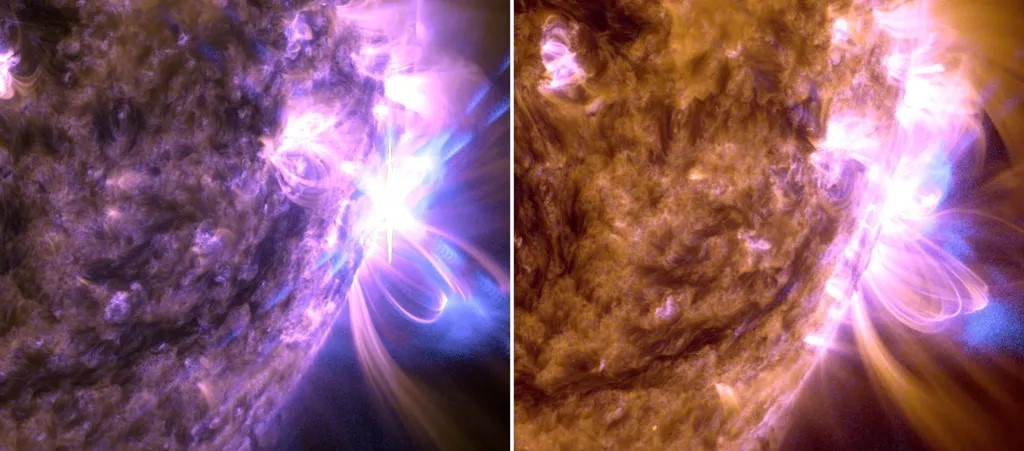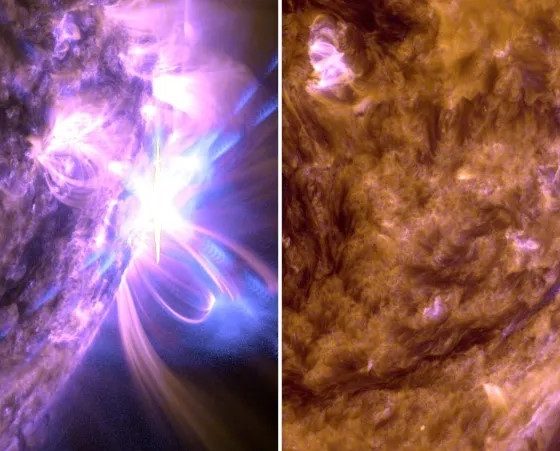

News
PHOTOS: Northern Lights provide stellar U.S. views as Starlink put under pressure by solar storm
Last weekend, Earth was directly hit by a major Solar storm, and millions were treated to a view of the Northern and Southern lights for the first time.
The storm triggered the Northern Lights to descend much further south than normal, providing brilliant moving lights in the skies usually reserved for those in the far northern and southern hemispheres.
Despite its raw beauty, the storms were a major cause of concern among satellite operators, including SpaceX, which, as of this writing, has 5,999 Starlink satellites orbiting around Earth.
Elon Musk posted, acknowledging that it would be a major test for their constellation, which had previously lost satellites due to Solar storm activity.
Major geomagnetic solar storm happening right now. Biggest in a long time. Starlink satellites are under a lot of pressure, but holding up so far. pic.twitter.com/TrEv5Acli2
— Elon Musk (@elonmusk) May 11, 2024
The Vice President of Starlink Engineering, Michael Nicolls, posted that all of their Starlink satellites, including those recently launched, survived the storm. The satellites that were recently launched were at a much greater risk as atmospheric drag increases and could cause an unintentional de-orbit.
Here are some of our favorite pictures we spotted over on X.
We’re not done with #NorthernLights photos right? Still going through my treasure chest of content and I think I have a new favorite. The colors, banding, pillars and arcs were just unbelievable to watch explode in the northwestern sky during this solar storm substorm. pic.twitter.com/LuyMt7o4Zc
— Nick Stewart (@NStewWX) May 13, 2024
A beautiful view of the Aurora Borealis from Nick Stewart who was in South Dakota.
As noted earlier, the Northern Lights were visibly much further South, including South Florida. The red hue of the lights seen from Florida is due to the Aurora being at a much higher altitude than the greens and blues seen further North.
Occasional pillars, but mostly a diffuse red glow at this point. Still incredible this far south. Taken along US-27 west of Fort Lauderdale, FL at 11:45pm. #aurora @NWSMiami @TweetAurora @AuroraNotify pic.twitter.com/m22PdWkRVL
— Luke Culver (@LukeCulverWx) May 11, 2024
One of the last major storms, known as the Carrington Event, occurred in 1859 with Aurora being visible as far South as Cuba. That storm ignited telegraph lines at the time, causing major outages. While this storm wasn’t as strong, there is always a risk to our current infrastructure, and luckily, it seems no satellite operators suffered any major damage or losses, and ground power stations suffered no blackouts.
The Sunspot that caused the Coronal Mass Ejections has now rotated away from Earth, but it doesn’t mean we are out of the line of fire, as a new one could pop up at any time and send another one our way. This storm provided a great test for satellite operators who now have valuable data to help sturdy their satellites against future Solar storms.
Check out some other awesome photos of the Northern Lights:
Northern lights over Mount Shasta in California, during the historic solar storm last night! #aurora pic.twitter.com/g5EBmPQ7WX
— Jeff Boyce (@Negative_Tilt) May 11, 2024
I’m sorry I didn’t share this sooner. Check out this AMAZING shot of the Northern Lights that was taken between Friday night & Saturday morning. This photo features the trifecta: Aurora Borealis, Milky Way & Mount St. Helens. Thanks to Ian Reed for sharing! pic.twitter.com/aqRGyJfvWv
— Jeff Forgeron (@WeatherJefe) May 15, 2024
Northern lights over NE Ohio. pic.twitter.com/FrdW1pR9M5
— Michael Collier (@MikeACollier) May 11, 2024
A super rare display of aurora borealis / northern lights washed over the Bay Area early this morning ✨
? by Pankaj Bhargava @punksworld on IG pic.twitter.com/FlWGpLUIi3
— DoTheBay (@DoTheBay) May 11, 2024
Were you able to witness this possibly once-in-a-lifetime event? If so, where were you able to witness the Aurora from?
Questions or comments? Shoot me an email at rangle@teslarati.com, or Tweet me @RDAnglePhoto.

Elon Musk
Starlink passes 9 million active customers just weeks after hitting 8 million
The milestone highlights the accelerating growth of Starlink, which has now been adding over 20,000 new users per day.

SpaceX’s Starlink satellite internet service has continued its rapid global expansion, surpassing 9 million active customers just weeks after crossing the 8 million mark.
The milestone highlights the accelerating growth of Starlink, which has now been adding over 20,000 new users per day.
9 million customers
In a post on X, SpaceX stated that Starlink now serves over 9 million active users across 155 countries, territories, and markets. The company reached 8 million customers in early November, meaning it added roughly 1 million subscribers in under seven weeks, or about 21,275 new users on average per day.
“Starlink is connecting more than 9M active customers with high-speed internet across 155 countries, territories, and many other markets,” Starlink wrote in a post on its official X account. SpaceX President Gwynne Shotwell also celebrated the milestone on X. “A huge thank you to all of our customers and congrats to the Starlink team for such an incredible product,” she wrote.
That growth rate reflects both rising demand for broadband in underserved regions and Starlink’s expanding satellite constellation, which now includes more than 9,000 low-Earth-orbit satellites designed to deliver high-speed, low-latency internet worldwide.
Starlink’s momentum
Starlink’s momentum has been building up. SpaceX reported 4.6 million Starlink customers in December 2024, followed by 7 million by August 2025, and 8 million customers in November. Independent data also suggests Starlink usage is rising sharply, with Cloudflare reporting that global web traffic from Starlink users more than doubled in 2025, as noted in an Insider report.
Starlink’s momentum is increasingly tied to SpaceX’s broader financial outlook. Elon Musk has said the satellite network is “by far” the company’s largest revenue driver, and reports suggest SpaceX may be positioning itself for an initial public offering as soon as next year, with valuations estimated as high as $1.5 trillion. Musk has also suggested in the past that Starlink could have its own IPO in the future.
News
NVIDIA Director of Robotics: Tesla FSD v14 is the first AI to pass the “Physical Turing Test”
After testing FSD v14, Fan stated that his experience with FSD felt magical at first, but it soon started to feel like a routine.

NVIDIA Director of Robotics Jim Fan has praised Tesla’s Full Self-Driving (Supervised) v14 as the first AI to pass what he described as a “Physical Turing Test.”
After testing FSD v14, Fan stated that his experience with FSD felt magical at first, but it soon started to feel like a routine. And just like smartphones today, removing it now would “actively hurt.”
Jim Fan’s hands-on FSD v14 impressions
Fan, a leading researcher in embodied AI who is currently solving Physical AI at NVIDIA and spearheading the company’s Project GR00T initiative, noted that he actually was late to the Tesla game. He was, however, one of the first to try out FSD v14.
“I was very late to own a Tesla but among the earliest to try out FSD v14. It’s perhaps the first time I experience an AI that passes the Physical Turing Test: after a long day at work, you press a button, lay back, and couldn’t tell if a neural net or a human drove you home,” Fan wrote in a post on X.
Fan added: “Despite knowing exactly how robot learning works, I still find it magical watching the steering wheel turn by itself. First it feels surreal, next it becomes routine. Then, like the smartphone, taking it away actively hurts. This is how humanity gets rewired and glued to god-like technologies.”
The Physical Turing Test
The original Turing Test was conceived by Alan Turing in 1950, and it was aimed at determining if a machine could exhibit behavior that is equivalent to or indistinguishable from a human. By focusing on text-based conversations, the original Turing Test set a high bar for natural language processing and machine learning.
This test has been passed by today’s large language models. However, the capability to converse in a humanlike manner is a completely different challenge from performing real-world problem-solving or physical interactions. Thus, Fan introduced the Physical Turing Test, which challenges AI systems to demonstrate intelligence through physical actions.
Based on Fan’s comments, Tesla has demonstrated these intelligent physical actions with FSD v14. Elon Musk agreed with the NVIDIA executive, stating in a post on X that with FSD v14, “you can sense the sentience maturing.” Musk also praised Tesla AI, calling it the best “real-world AI” today.
News
Tesla AI team burns the Christmas midnight oil by releasing FSD v14.2.2.1
The update was released just a day after FSD v14.2.2 started rolling out to customers.

Tesla is burning the midnight oil this Christmas, with the Tesla AI team quietly rolling out Full Self-Driving (Supervised) v14.2.2.1 just a day after FSD v14.2.2 started rolling out to customers.
Tesla owner shares insights on FSD v14.2.2.1
Longtime Tesla owner and FSD tester @BLKMDL3 shared some insights following several drives with FSD v14.2.2.1 in rainy Los Angeles conditions with standing water and faded lane lines. He reported zero steering hesitation or stutter, confident lane changes, and maneuvers executed with precision that evoked the performance of Tesla’s driverless Robotaxis in Austin.
Parking performance impressed, with most spots nailed perfectly, including tight, sharp turns, in single attempts without shaky steering. One minor offset happened only due to another vehicle that was parked over the line, which FSD accommodated by a few extra inches. In rain that typically erases road markings, FSD visualized lanes and turn lines better than humans, positioning itself flawlessly when entering new streets as well.
“Took it up a dark, wet, and twisty canyon road up and down the hill tonight and it went very well as to be expected. Stayed centered in the lane, kept speed well and gives a confidence inspiring steering feel where it handles these curvy roads better than the majority of human drivers,” the Tesla owner wrote in a post on X.
Tesla’s FSD v14.2.2 update
Just a day before FSD v14.2.2.1’s release, Tesla rolled out FSD v14.2.2, which was focused on smoother real-world performance, better obstacle awareness, and precise end-of-trip routing. According to the update’s release notes, FSD v14.2.2 upgrades the vision encoder neural network with higher resolution features, enhancing detection of emergency vehicles, road obstacles, and human gestures.
New Arrival Options also allowed users to select preferred drop-off styles, such as Parking Lot, Street, Driveway, Parking Garage, or Curbside, with the navigation pin automatically adjusting to the ideal spot. Other refinements include pulling over for emergency vehicles, real-time vision-based detours for blocked roads, improved gate and debris handling, and Speed Profiles for customized driving styles.








